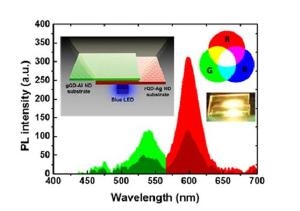Jan 25 2018
Researchers at KAIST have come up with a technology that improves the efficiency of Quantum Dot Light-Emitting Diodes (LEDs).
 This is a spectrum showing different fluorescence with and without metallic nanostructure. (Image credit: KAIST)
This is a spectrum showing different fluorescence with and without metallic nanostructure. (Image credit: KAIST)
Professor Yong-Hoon Cho from the Department of Physics and his team have been successful in enhancing the efficiency of Quantum Dot (QD) LEDs by developing metallic nanostructure substrates.
QD LEDs contain very small semiconductor light sources and are said to be the latest emerging technology for high performance full-color display. However, it is costly to manufacture displays with just QD LED.
Current QD-based displays apply blue LEDs as a source of light, and they employ a technique of color conversion through excitation of red and green QDs.
There are two issues with the current QD-based displays. As stated earlier, QD LED is not economical, therefore the unit price of QD-based displays is more. Furthermore, the efficiency of a liquid type of QDs significantly reduces after contact with air.
Professor Cho found the solution in a metallic nanostructure for bringing down the production cost while enhancing the efficiency of QD LEDs.
When nanoscale metallic structures are exposed to light, the team took advantage of the phenomenon of so-called surface plasmonic resonances. Based on the metal, the shape, and the size, the properties of metallic structures differ.
The team used different metallic nanostructures for each QD LED - aluminum nanodisks for Green GDs and silver nanodisks for Red QDs and - to make them more fluorescent.
With brighter QDs, it requires smaller number of QDs to manufacture QD LEDs, contributing to a lower unit cost. The team used aluminum and silver in this research, but metallic nanostructures can be redesigned according to the preferred purposes.
Implementing metallic nanostructures into QD LEDs in a proper manner can reduce the quantity of the QDs required for the system, leading to lower unit prices.
Professor Yong-Hoon Cho
This research, headed by PhD candidate Hyun Chul Park, was selected as the cover of the international journal, Small, on December 27, 2017.